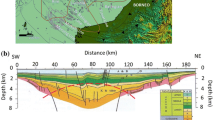This paper addresses the challenge of accurately describing the boundary of deep cavern-type reservoirs. A method is developed to extract diffraction information from the cavern and its boundaries from full wavefield seismic data using PCA wavefield separation technology. The paper describes a method for extracting diffraction information based on post-stack seismic data, and demonstrates the validity of this method in identifying cavern’s boundaries via forward modeling. Subsequently, the method is applied to actual seismic data to extract diffraction information from deep caverns. By separating wavefield information at different scales, the extracted diffraction information can effectively identify the characteristics of cavernous reservoirs and their boundaries. It is verified by examples that the diffraction wave information separation method can provide a more accurate description of the distribution of deep cavern-type reservoirs, which can provide a basis for predicting this type of reservoir.








Similar content being viewed by others
References
Klem-Musatov K. D., Aizenberg A. M., et al. Edge and tip diffractions theory and applications in seismic prospecting [M]: SEG, 2008.
Gallop J. B., Hron F. Diffractions and boundary conditions in asymptotic ray theory [J].Geophysical Journal International, 1998, 133(2):413-418.
Taner M.T., et al. Prestack separation of seismic diffractions using plane-wave decomposition [C]. SEG, Expanded Abstracts, 2006: 2401-2404.
Ivan P., Aaron S. Fracture detection through seismic cube orthogonal decomposition [C].SEG Annual Meeting, 2013: 1308-1313.
Li Chuangjian, et al. Separating and imaging diffractions of seismic waves in the full-azimuth dip-angle domain [J]. Journal of Geophysics and Engineering, 2020, 17 (2): 339-356.
Sergius Dell, et al. Using seismic diffractions for assessment of tectonic overprint and fault interpretation [J]. Geophysics, 2019, 84(1).
Xie Wei, BI Chen-chen, Hu Hua-feng, et al. Development and Application of an Identification Method for Fracture and Cave in Carbonate Reservoir Based on Diffracted Wave[J]. Science Technology and Engineering, 2021, 21(02): 453-457.
Shu Mengcheng. Diffraction Wave Attributes to Identify Small-Scale Geological Bodiesournal [J] Geofluids, 2022, Volume, Issue.
Taylor, et al. Geophysics; Studies from A. Klokov et al Provide New Data on Geophysics (Reef Delineation By Offset Vertical Seismic Profiling And Seismic Diffractions) [J] Journal of Technology & Science, 2015, Volume , Issue.
AI-Dossary S, Simon Y. Marfurt K J. Inter azimuth coherence attribute for fracture detection [C]. SEG Technical Program Expanded Abstracts, 2004, 23: 183-186.
Zhao Jingtao.Research on analysis and extraction method of diffraction information[D]. Beijing: University of Chinese Academy of Sciences, 2013.
Zeng Jinguang,et al. A method for the study of reservoir fracturing based on structural principal curvatures[J]. Chinese Journal of Theoretical and Applied Mechanics, 2008, 1982(2): 202-206.
Zhang Hong,et al. Prediction of paleokarst reservoir in the southeastern slope of Tazhong area in Tarim Basin using seismic techniques[J]. Editorial office of Acta Petrolei Sinica, 2008, 29(1): 69-74.
Qian Rongjun. Seismic wave characteristics and related technical analysis [M]. Beijing: Petroleum Industry Press, 2008.
Taner M. T., et al. Prestack separation of seismic diffractions using plane-wave decomposition [C]. SEG, Expanded Abstracts, 2006, 2401-2404.
Shu Mengcheng. The integrated description method of fracture-vuggy reservoir and gas reservoir [D]. Beijing: University of Chinese Academy of Sciences, 2014.
Li Xueliang. Study on diffraction wave imaging and its application in fracture prediction [D]. Beijing: University of Chinese Academy of Sciences, 2012.
Author information
Authors and Affiliations
Corresponding author
Additional information
Translated from Khimiya i Tekhnologiya Topliv i Masel, No. 6, pp. 167–172, November – December, 2023.
Rights and permissions
Springer Nature or its licensor (e.g. a society or other partner) holds exclusive rights to this article under a publishing agreement with the author(s) or other rightsholder(s); author self-archiving of the accepted manuscript version of this article is solely governed by the terms of such publishing agreement and applicable law.
About this article
Cite this article
Wei, H., Huang, W., Ji, T. et al. The Method of Seismic Diffraction Wave Extraction Based on PCA Method and its Application. Chem Technol Fuels Oils 59, 1313–1320 (2024). https://doi.org/10.1007/s10553-024-01647-4
Published:
Issue Date:
DOI: https://doi.org/10.1007/s10553-024-01647-4




